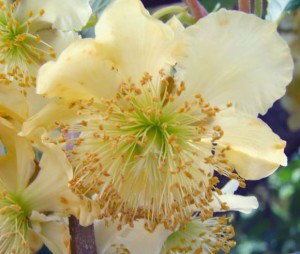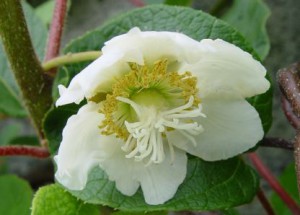The kiwifruit plant is dioecious, which means there is a male plant that pollinates a female plant, which will in turn produce fruit.
The ratio normally used for the most efficient pollination is one male vine to 3-8 female vines, which will ensure maximum fruit yield per surface area.
Warning: some self-pollinating varieties are sometimes suggested, but in my experience the yield is inferior to pollinated varieties. If you already own a self-pollinating kiwifruit vine, you can just pollinate it with a male vine to increase its yield to the same level as a normal dioecious variety.
Male and Female Kiwifruit Plants
You can easily distinguish which plant is male or female by simply looking at a fully-developed flower: I have included some images for reference.
Male plants have pollen on the central anthers, as well as on the external ones. They all tend to be green in color and are quite homogeneous in their appearance.
The petals are of a slightly darker color than the female counterpart.
Female plants, on the other hand, have a central group of white stigmas, and an external group of anthers with fake pollen.
This fake pollen exists for the sole purpose of tricking bees into rubbing on the anthers for pollination purposes.
The role of bees in kiwifruit pollination
Kiwi vines are among the most difficult fruit-bearing plants to pollinate, since their pollen is not particularly attractive to bees, so don’t expect it to be easy, especially if you’re just trying to grow kiwi in your garden.
Commercial producers usually exploit the role of bees by placing up to 9-10 hives per hectare, which basically overpopulates the area with bees, ensuring they help pollinate the kiwifruit vines by competing for survival. The process can be made even more effective by using highly-pollinating bee breeds (bumblebees in particular seem to be more efficient at kiwi pollination).
Work was also started in the 80’s in New Zealand to find a way to manually spray male pollen onto females for artificial pollination. This system is still undergoing experimentation but the results seems to be promising.
Consider why you want to pollinate the vines
With that said though, pollinating kiwi is probably not a good idea itself: most industrial farms employ a much simpler method that yields superior results, and that is to simply graft a fruit-producing vine onto the rootstock grown from seeds of any kiwi vine, or even better from the cuttings of a mature plant.


